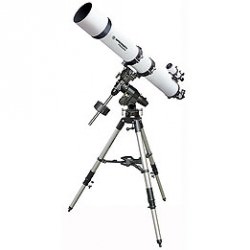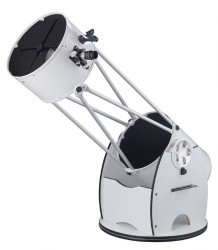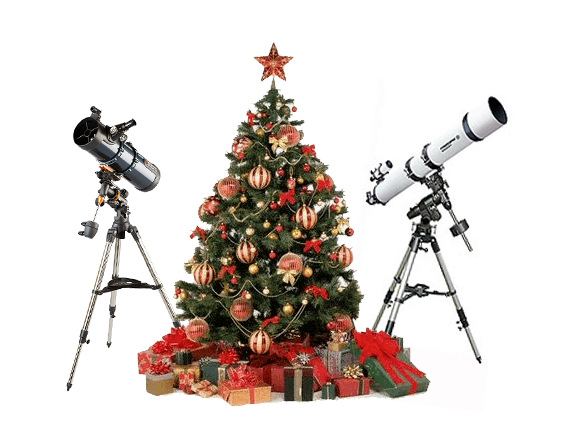The holidays are fast approaching, and you may be looking for gift ideas for your friends, loved ones and even yourself. Are you considering buying a telescope this year?
There are many different types of astronomical telescope available on the market and for the beginner, selecting one can be a bewildering experience. Before buying a telescope it is important to ask yourself: What objects do you want to see through your new telescope and how much can the person buying it afford to pay?
Not all telescopes are the same nor do they give the same results. Many amateur astronomers have two or more different telescopes for different types of observing, but there are some which offer a good compromise and most objects can be seen through them.
Once you have decided on the telescope’s main purpose and what you want to see through it, choosing one can become much easier. With the exception of the Moon, planets and close star clusters, interesting night sky objects are faint; in fact most will appear as just points of light. As a new observer you may be mainly interested in viewing the Moon and planets, and if this is the case, a telescope with a small objective (primary mirror or lens) may be sufficient.
Most observers quickly graduate to galaxies, nebulae, globular clusters, open clusters etc. To view these objects you will require a telescope with the largest aperture that is possible for your circumstances, which includes things like cost, weight, portability, etc.
Below are the 3 main types of telescope worth considering as a beginner:
Newtonian reflector telescopes are a popular choice for astronomical use because they have the lowest cost per inch of aperture. Observations of faint deep sky objects, such as Galaxies and Nebulae, can be achieved at a relatively reasonable cost by reflectors with mirror diameters of 150 to 200mm (6 to 8 inches).

Refractor telescopes are good for achieving high power and contrast when viewing the planets and the moon. They have a reputation of providing crisp, sharp-quality images. Since they are virtually maintenance free, they are easy to operate, but due to high costs for the large aperture scopes, most beginners will choose a Newtonian reflector as a first scope for all round astronomy. Short-tube refractors are now another low cost option for beginners. Their smaller size makes them an excellent choice for a portable telescope and the beautiful wide-field star vistas which they provide are great for learning your way around the night sky.

Dobsonian Telescopes are one of the best choices for a general telescope and have many advantages including simplicity, economy and large light gathering ability. Dobsonians are actually large Newtonian telescopes on a simple manual Alt/ Az (Up, down, side to side) mount. Due to the mount and optical tube assembly being so simple, Dobsonian telescopes are the most economical on a cost per inch basis. This enables massive apertures being made affordable, bringing fainter objects within the grasp of the amateur and usually well within budget with mirror diameters from 150mm to 400mm (6 to 16 inches) or much larger.

Another consideration when choosing a telescope is the mount – the part the optical tube assembly sits on. Usually a tripod with a head containing manual or motorised controls, which point the telescope and track an object observed.
The three main types are:
Equatorial – Usually found paired with all telescopes apart from Dobsonians. Equatorial mounts enable the telescope to follow the rotation of the sky with on axis parallel to the Earth’s axis of rotation. They can also be used in a basic manual mode which can be manually moved by hand in the Altitude (up/down) and Azimuth (left/right) axis. Many higher end mounts have computers and GoTo systems incorporated which are almost essential for astrophotography.
Hand operated Manual Alt/ Az (Altitude/ Azimuth) – Usually found on very cheap or small telescopes, Dobsonian telescopes, binocular mounts and photographic tripods. Simple and easy to use, however they do not track objects across the sky.
GoTo or Computerised – Found on many mid to high range telescopes of all sizes and extremely popular with astrophotographers and imagers. Unfortunately many beginners are drawn to the sexy marketing of scopes that are computerised and this can be an expensive mistake. Personally I believe it to be better to use manually guided telescopes when starting out instead of jumping in straight away with computerised ones. It is much better to concentrate on good optics and a solid mount rather than waste lots of money on often complicated and unnecessary electronics. For more info on mounts and GoTo Systems see the Beginners Guide to GoTo
Hopefully this guide has given you more insight into the complicated world of telescopes, and enable you to make a better decision when buying your new telescope. Your new purchase should be one that you can enjoy and get the most out of for many years.


This is a great text – just what I wanted to know!
I actually disagree on the GoTo point. I’m an (extreme) amateur and the scope i bought came with GoTo – i didn’t buy it for the GoTo, but i am extremely glad i got it. I would have given up long ago and packed it in the cupboard without it.
Especially in a light polluted area, its hard to find things when you don’t know the sky, and I don’t think i would have stuck with it! It does (slowly) teach you as you learn which stars are what etc, obviously not as good as doing it properly with star hopping charts etc.
While i agree that it’s not worth spending extra money on over aperture, i don’t think beginners should disregard it.
I’ve got a 8″ dobsonian reflector that I received last Christmas. What are some of your choices for eyepieces and filters?
Plossls are the typical eyepiece that most amateurs begin with. Some of the higher quality ones are quite good. I recently purchased a Meade 5000 Series 26-mm Plossl because it was the lowest power EP I could find with a 1.25″ barrel for use in an older SCT equipped with a 1.25″ diagonal. This EP has an AFOV of 60-deg, better than the typical 52-deg to 55-deg AFOV typical of the Plossl design. (On sale at OPTCorp, this EP was $85.) If you have ever looked through a wide-angle EP, then it is difficult to go back to 55-deg Plossls. I have populated my EP collection with two types of EPs. I like the Baader Planetarium Hyperion EPs, which have a 68-deg AFOV. They come in these sizes: 5, 8, 10, 13, 17, 21, 24, 31, 36. Those below 31 mm are priced at $129, a very good value. I have the 5, 8, 17, and 24. I also recommend 82-deg AFOV EPs. Three manufacturers currently offer 82-deg EPs: Televue, Meade, and Explore Scientific. Televue are considered the benchmark, but I have found the Meades and ES versions to be quite good. The Meades and ES’s can be picked up on sale occasionally. The ES ones are still on sale, I believe. I have the Meade 6.7, 8.8, and 14; also the ES 11 and 18 (a 2-inch barrel). My EPs are mainly used in my refractors of 80-mm, 102-mm, and 150-mm aperture, so I tend to have medium to short focal length EPs. (I also have a 10-inch dob.) I don’t much use filters, but a good narrowband nebular filter is recommended if you like going after nebulas. The best view I ever had of the Veil Nebula was through someone’s 24-inch Obsession dob with a 41-mm Televue Panoptic (68-deg) EP and a OIII filter (the one to buy after a narrowband). I am not much of a planetary observer, so I really can’t comment about color filters, which are often used to enhance views of the planets.
I often get asked by parents attending star watches with their children what a good “beginner” telescope would be. I can without hesitation recommend the Celestron FirstScope, a 76-mm reflector on a table-top dobsonian mount. This scope normally lists for $49.95, which is a good value (especially since the 50-mm Galileoscope refractor kit popularized during the 2009 International Year of Astronony now costs between $50 and $60, depending on where purchased). The absolute best price on the FirstScope can be found at B&H Photo (mail order in NYC). B&H is offering the FirstScope (which comes with a R&P 1.25″ focuser and two eyepieces–4 mm and 20 mm) AND the Accessory Kit (6-mm and 12.5-mm eyepieces, Moon filter, 5×24 finderscope and bracket, CD-ROM with The Sky X planetarium program, and a nylon carrying case for the scope and EPs) AND a 13-mm Plossl eyepiece for $39.95. Having stumbled on this, I immediately ordered one (for teaching and demonstration purposes). I have checked out the Moon, and the views are really quite good. The 4 EPs that come with the scope and accessory kit are below Plossl grade but work adequately and will more than meet a child’s expectations. B&H’s decision to throw in the 13-mm Plossl is a nice bonus and shows the Moon fully in the field of view. So, for grandparents thinking of paying $55 for the bogus “named” star certificate from the International Star Registry (note that only the International Astronomical Union–IAU–can name celestial objects) for a grandchild, spend $40 and get that child a real telescope.
For general stargazing, I prefer binoculars. They are much faster, and easier to use, and the image it not reversed or flipped, making tracking moving objects (satellites) easier.
For the moon and planets, a telescope is better. It’s a steadier view, and magnification is usually much greater. Even entry-level models can give you good results. I found a Meade refractor in a thrift store for $20 this weekend. After a little TLC I was able to view Jupiter’s disc and Galilean moons. I was even able to view cloud bands on Jupiter. Light pollution has made it difficult for me to see nebulae to galaxies so far.
Keep in mind that it takes a lot of patience to find small items. You might want to practice looking at distant trees or something during the day. (Avoid the Sun!!)